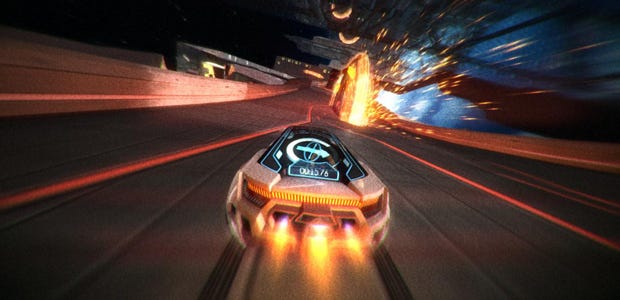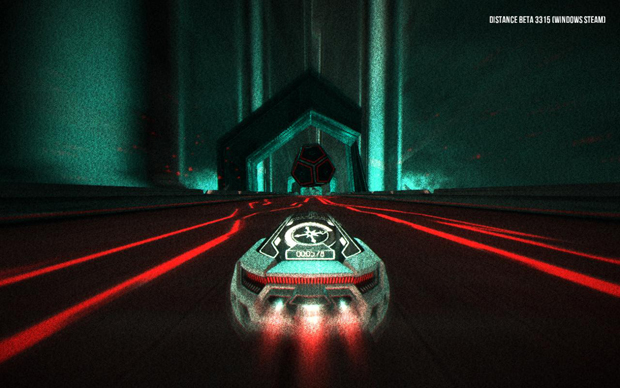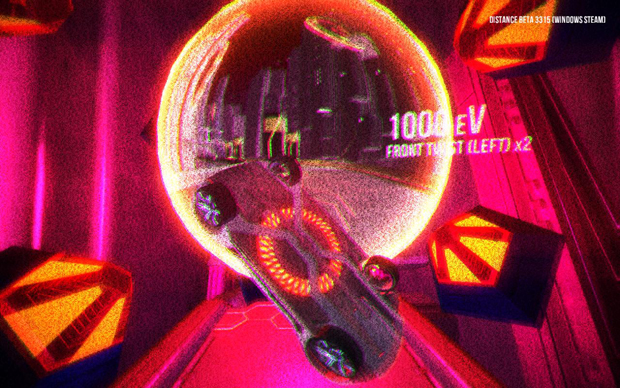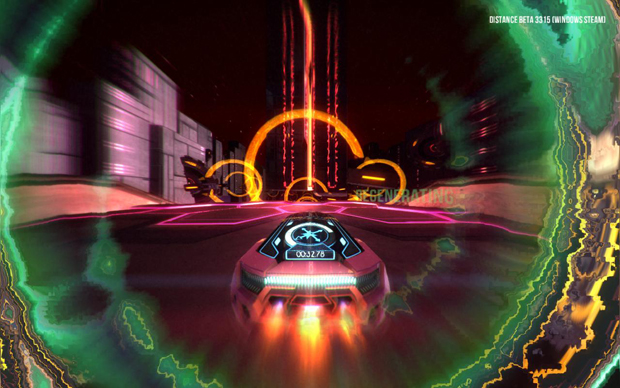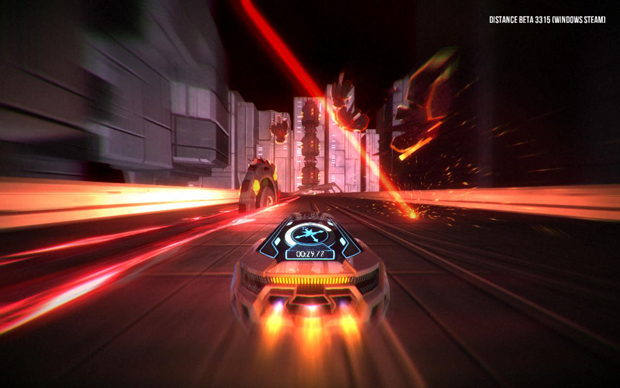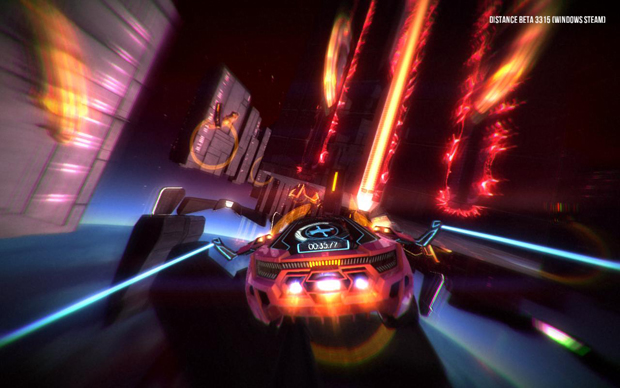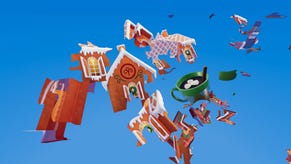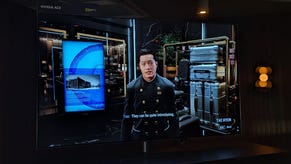Premature Evaluation: Distance
From the Tron side of the track
Each week Marsh Davies revs his engines and tears off into the nightmarish neon digiscape of Early Access and returns with any stories he can find and/or skid marks. This week he speeds into the distance in, er, Distance - a hallucinatory “Survival Racing” game.
“Survival Racing” say the developers. It’s an ominous appellation that suggests players might have to rumble along the verges on wooden wheels, shunting rubber trees until they’ve shaken enough ingredients loose to build some tyres. Fear not - Distance isn’t that sort of survival game. It is, in fact, a time-attack obstacle course apparently set inside the cheese-dream of a Tron lightcycle. You play as some sort of car AI in some sort of collapsing simulation - the “story” of the story mode is just as deep as it needs to be - and you must speed through these pulsating landscapes of monolithic black shards and streaking neon, all while avoiding inexplicable laser hazards and performing rad stunts. Naturally, there is a throbbing electro soundtrack, too.
It’s already terrifically entertaining. Merely weaving through the stacks and overpasses of this world to the pulse of the music offers a baseline level of aesthetic scintillation, but the game builds and builds upon its core driving model until you are flipping between perpendicular roadways, flying, boosting, jumping with split-second precision as the rhythm pounds and the environment itself contorts and explodes. Cool.
The driving model initially seems lacking in nuance - your car jinks side to side without any perceptible concession to physics: your back-end never flies out, your wheels never lift and your suspension never struggles. But that is the necessarily bland vanilla base on which Distance splurts its hot vehicular sauce.
Sure, there are obstacles, erupting onto the track with a pre-emptive flash, forcing you to dodge or jump in tempo - but these are merely colourful sprinkles. The true flavour of this delicious car-cone is boost. While you accelerate with the right-trigger, a thumb on the A button injects a shuddering burst of speed that sets your exhausts alight. It’s necessary to see you sail across a given level’s many chasms, but the longer you boost, the more you overheat, strips of lights along your back bumper indicating the level of alarm, until, eventually, you detonate. Archways along the track reset your temperature (and regenerate parts of your car that might have been sliced off by lasers) - and these have been positioned with an astute sense of pace, challenging you to gauge your boosts down to the millisecond, eking out all the speed you can. Somehow - brilliantly - this tension seems to map almost perfectly to the music.
You can also bring down your temperature by performing aerial stunts - jumping then using the right analogue stick to fire lateral thrusters, sending you into a 360 spin before landing back on your wheels. Often this trick is necessary to reorient your car to an entirely new road surface, flipping off a jump then landing on what was previously a wall while the roadway falls into the abyss. This I found to be a degree more finicky than anything else in the game: the camera sometimes instantly rotates to match and at other times the game seems to get flustered, allowing your car to come within centimetres of touchdown and then drift away into oblivion, as it settles on some other gravitational orientation.
Sometimes, within an abruptly coiled tunnel, a jump may cause your car to come to a halt mid-air, as the game struggles to work out which of the many nearby surfaces should count as the floor. Though analogue control makes it more of a precise skill test, given that the physics here takes second place to smoke and mirrors, I wonder if a more digital alternative would be better - tapping the bumpers to spin 45 degrees.
It may be that I am just shit at being a cheese-dream magical computer car, but it does seem to stand out as the one obstacle that really nobbles me: the rest of the game is a little too easy. I don’t really mind this, as I play the game for the sensation, the thrilling synaesthesia of sound and vision and action. But even when taken to the competitive stage, the grading of challenge seem a little out of whack: I got a gold first time on every level I played in the leaderboard-led Sprint mode, and that accommodated at least one substantial fuck-up per track. I’m no masochist when it comes to gaming, but even I feel it’s rather too lenient.
It also seems a little light. I blitzed the story mode’s campaign in an hour or so - and though it promises to grow somewhat, the developers stress that it will always be short. They must hope that the substance of the game is to be found in competing for time or score on the leaderboards, or digging through the Steam Workshop’s abundant player-made levels. I suspect this may be a bit of a mistake, if only from a marketing perspective: players always tend to perceive the amount of structured original content that ships with a game as the dipstick of value. You can have the most lively online community and all the user-generated content you want, but if your campaign is just ten levels long you’ll have people demanding their money back because they “beat” the game too quickly.
I don’t know that they’d be entirely wrong in this case: it’s the drip-feed of new exotic challenges that gives the campaign such a powerfully exhilarating appeal, and you won’t find that in the user-generated levels to the same extent; though the level editor is monstrously powerful, its output is still mechanically circumscribed, and it’s perhaps the delivery and abundance of new mechanics that is my dipstick of value.
Slight though it is, Distance is already a robust arcade offering and regardless of how much content the developers themselves deliver, the presence of split-screen and online multiplayer ensures it an extended lease of life, even if you don’t care about chasing numbers up a scoreboard. The levels themselves are worth replaying too, not simply to get better at them, but because as you push towards that skill-ceiling entirely new routes and interesting sights become apparent to you. When you establish that your car can fly, too, it opens up numerous possibilities for how the game might be extended. Purely aerial user-made levels are a guarantee. But it’s the campaign that’s won me round, not just with the exciting escalation of its aerobatic skills, but in the rare aesthetic of its backdrop - a cyber-horror unreality unravelling itself to the sound of searing synth. I hope I’ve seen only the first part of this alarming, thrilling trajectory; Distance deserves to go much further.
Distance is available from Steam for £15. I played beta 3315 on 10/01/2015.
